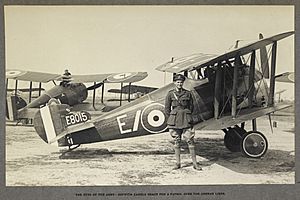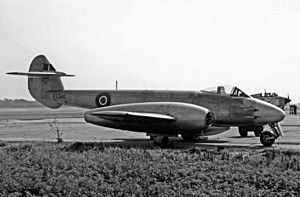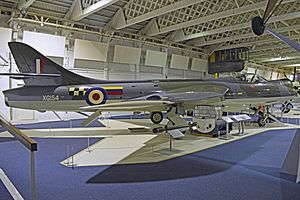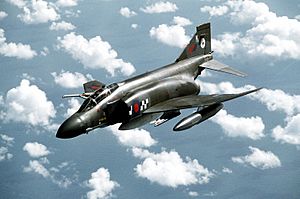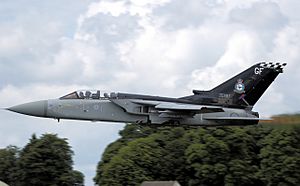No. 43 Squadron RAF facts for kids
Quick facts for kids No. 43 (China-British) Squadron RAF |
|
|---|---|

No. 43 Squadron badge
|
|
| Active | 15 April 1916 – 1 April 1918 (RFC) 1 April 1918 – 31 December 1919 (RAF) 1 July 1925 – 16 May 1947 1 February 1949 – 14 October 1967 1 September 1969 – 13 July 2009 |
| Country | |
| Branch | |
| Nickname(s) | 'The Fighting Cocks' |
| Motto(s) | Latin: Gloria finis ("Glory is the end") |
| Battle honours |
|
| Insignia | |
| Squadron Badge | A Gamecock |
| Squadron Roundel |  |
| Squadron Codes | NQ (Nov 1938 – Sep 1939) FT (Sep 1939 – May 1947) SW (Feb 1949 – Apr 1951) AA–AZ (1986 – Jul 1989) GA–GZ (Sep 1989 – June 2009) |
No. 43 Squadron, known as the Fighting Cocks, was a famous Royal Air Force (RAF) aircraft squadron. It started in April 1916 as part of the Royal Flying Corps. The squadron played a big part in both World Wars. Many skilled pilots, called "aces," flew with them.
The squadron's last aircraft was the Panavia Tornado F3. They used it for air defence from RAF Leuchars, Scotland. The squadron was officially closed down in July 2009.
Contents
Squadron History
World War I: Early Days
No. 43 Squadron began in Stirling, Scotland, on April 15, 1916. It was part of the Royal Flying Corps. At first, they used different planes for training. In December 1916, they got Sopwith 1½ Strutter planes.
These planes were sent to the Western Front in France. There, the squadron flew missions to scout for enemy positions and fight other planes. In September 1917, they started using Sopwith Camels. They used these planes for attacking targets on the ground until the war ended.
The squadron received Sopwith Snipe planes in August 1918. But the war ended with the Armistice in November 1918. So, these new planes didn't see much action. The squadron then moved to Germany for occupation duties. It was later disbanded on December 31, 1919.
During World War I, ten "aces" served in the squadron. These included Henry Woollett and John Lightfoot Trollope. All of them survived the war.
Between the Wars: The Fighting Cocks
The squadron was started again on July 1, 1925, at RAF Henlow. They flew Sopwith Snipes again. In 1926, they switched to Gloster Gamecocks. This is where their famous nickname, "The Fighting Cocks," came from. Their black and white checkered markings also started around this time.
The squadron later flew Armstrong Whitworth Siskins from 1928. In May 1931, they received the first Hawker Fury Mk.I planes.
World War II: Global Conflict

Before World War II began, the squadron got new Hawker Hurricane Mk.I planes. These were important fighter planes.
On February 3, 1940, three Hurricanes from No. 43 Squadron shot down a German Heinkel He 111 bomber. This happened near Whitby, England. It was the first German plane to crash on English soil in World War II. Flight Lieutenant Peter Townsend led this mission.
Still flying Hurricanes, the squadron helped cover the retreat of soldiers at Dunkirk. They also fought bravely in the Battle of Britain. This was a major air battle over Britain in 1940.
In November 1942, No. 43 Squadron moved to North Africa. There, they flew Supermarine Spitfire Mk.Vc planes.
By 1944, the war was turning in favor of the Allies. The squadron moved to France. The local French people called them "les coqs Anglais" (the English cocks). Their main job was to attack ground targets. They would shoot at and bomb enemy positions. The squadron ended the war in Austria. It was disbanded on May 16, 1947.
The Jet Age: New Planes and Missions
No. 43 Squadron was reformed on February 1, 1949. They started flying Gloster Meteor F.4 jet planes from RAF Tangmere. In 1950, the squadron moved to RAF Leuchars in Scotland.
In 1954, they were the first squadron to get the new Hawker Hunter F.1 jets. These replaced their Meteor F.8s. The Hunters of No. 43 Squadron even appeared in the 1957 movie High Flight. They later received the Hunter FGA.9 in May 1960.
The Fighting Cocks moved to RAF Nicosia, Cyprus, in June 1961. Then, on March 1, 1963, they moved to RAF Khormaksar, Aden. They became part of the Middle East Command. Soon after arriving, they flew missions in the Beihan region. This was to show their strength against the Mutawakkilite Kingdom of Yemen.
Between April and May 1964, the squadron helped in the Radfan Campaign. They provided air support for ground troops. They also sent detachments of Hunters to places like Bahrain and Kenya.
The squadron flew many missions in 1965 and 1966. These included attacking rebel camps and providing air cover for ground forces. They also did training exercises. On April 15, 1966, the squadron celebrated its 50th anniversary with a special flypast.
In 1967, the squadron continued flying many sorties. This included attacking rebel positions and providing air cover. October 1967 was their busiest month in Aden. No. 43 (F) Squadron was officially disbanded on October 14, 1967. However, operations continued until November, when South Yemen became independent.
The Phantom Years: Supersonic Speed
No. 43 (Fighter) Squadron got its first McDonnell Douglas Phantom FG.1 jet on June 6, 1969. This was at RAF Leuchars. The squadron officially reformed there on September 1, 1969. They became part of the Northern Quick Reaction Alert (QRA) force. This meant they were ready to launch quickly to defend the skies.
In November 1970, the squadron sent eight Phantoms to RAF Luqa, Malta. They took part in an exercise to work better with the Royal Navy. The squadron also deployed to Malta for training camps in 1973, 1975, and 1978.
On September 18, 1975, the squadron lost its first Phantom. The plane crashed near Forfar, Angus, but both pilots ejected safely. On July 9, 1981, another Phantom was lost due to an instrument failure. Again, both crew members ejected safely.
In 1986, No. 43 (Fighter) Squadron celebrated its 70th anniversary. They gave one of their Phantom jets a special paint scheme to mark the occasion. The squadron's last Phantoms left Leuchars on July 31, 1989. This was to get ready for their new aircraft.
The Tornado Years: Modern Air Defence
The first Tornado F.3 jets arrived at Leuchars in September 1989. With the Tornado F.3, the squadron took part in the 1991 Gulf War. They also helped patrol the Iraqi no-fly zones.
Later, No. 43 (F) Squadron crews were on QRA duty. This meant they were ready for quick air defence "scrambles" in Scotland. They also served in the Falklands as part of No. 1435 Flight. The squadron also participated in Operation Telic in Iraq.
In 2005, the squadron was given the "Freedom of the City" of Stirling. This was because Stirling was their original home. To celebrate their 90th anniversary, one of the squadron's Tornado jets got a special black paint scheme.
In April 2008, the squadron took on the role of training new Tornado F.3 pilots. This was by absorbing No. 56 (Reserve) Squadron.
No. 43 (F) Squadron was officially closed down for the fourth time on July 13, 2009. There were rumors that it might reform as a Eurofighter Typhoon squadron. However, the squadron's flag, called the Squadron Standard, was laid up in a church in Stirling in May 2016. This showed that the unit would not be reformed.
Famous Pilots
- Flight Lieutenant Peter Townsend was one of three pilots from No. 43 Squadron who shot down a German bomber in 1940. This was the first enemy plane to crash on English soil in World War II. He was a skilled pilot during the war.
- Barrie Heath shot down four German planes between 1940 and 1941. After the war, he became the chairman of a large engineering company.
- Eugeniusz Horbaczewski (Dziubek), a Polish Air Force pilot, fought with No. 43 Squadron in 1943. He shot down several enemy planes over Malta, Sicily, and Italy.
- Squadron Leader (Acting) Peter Parrott was famous for being a "poster boy" in a recruitment campaign. He fought in the Battle of Britain.
- Thomas Dalton-Morgan fought with No. 43 Squadron during the Battle of Britain. He was credited with destroying many enemy aircraft. He also had the most night kills for an RAF pilot in a single-seat fighter during the war.
- Hamilton Upton was the highest-scoring Canadian flying ace during the Battle of Britain. He destroyed eleven German aircraft.
Aircraft Flown
No. 43 Squadron operated many different aircraft types throughout its history. Here are some of them:
- Armstrong Whitworth F.K.3 (1916)
- Royal Aircraft Factory B.E.2c (1916)
- Avro 504 (1916)
- Bristol Scout (1916–1917)
- Sopwith 1½ Strutter (1916–1917)
- Sopwith Camel (1917–1918)
- Sopwith Snipe (1918–1919; 1925–1926)
- Gloster Gamecock Mk.I (1926–1928)
- Armstrong Whitworth Siskin Mk.IIIa (1928–1931)
- Hawker Fury Mk.I (1931–1939)
- Hawker Hurricane Mk.I (1938–1941)
- Hawker Hurricane Mk.IIa (1941–1942)
- Hawker Hurricane Mk.IIb (1941–1942)
- Hawker Hurricane Mk.IIc (1941–1943)
- Supermarine Spitfire Mk.Vc (1943–1944)
- Supermarine Spitfire Mk.IX (1943–1947)
- Supermarine Spitfire Mk.VIII (1944)
- Gloster Meteor F.4 (1949–1954)
- Gloster Meteor F.8 (1950–1954)
- Hawker Hunter F.1 (1954–1956)
- Hawker Hunter F.4 (1956–1958)
- Hawker Hunter F.6 (1956; 1958–1960)
- Hawker Hunter FGA.9 (1960–1967)
- McDonnell Douglas Phantom FG.1 (1969–1989)
- McDonnell Douglas Phantom FGR.2 (1988–1989)
- Panavia Tornado F.3 (1989–2009)


